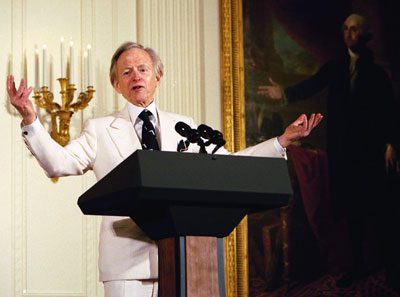Death of a New Journalist
By • May 17, 2018 0 482

Tom Wolfe died Monday, May 14.
Seeing that, hearing that, you immediately, and perhaps without thinking, and unfairly, thought of the suits, the multitudes of them (including some not white), in combination with carefully prepared ties, or colorful bow ties or white hats, sometimes standing up, sometimes seated, legs crossed, a slight, confident smile on his face, time passing by on the images page, where also fluttered images of Thomas Wolfe, another classic American writer in full.
Wolfe, the man in the many photographs, was 88, and the images range across the years, including a boyish young man, in high school or college or older, but also a buoyant man under a much-honored White House chandelier.
There are hardly any other kind of images to be seen, not driving a car, sweatered or reading a newspaper. You think, maybe because we live in an age of cinematic superheroes, that the suit, the clothes amount to a kind of disguise, certainly a pose or an alter ego, a sort of Southern Gentleman Caller of note and interest.
This was not, to reference the title of Wolfe’s second novel, Tom Wolfe, the man in full. For that, you go the words, words or, as he might put it: THE WORDS!
That’s where you’ll find Wolfe, among the ink-stained typesetters and machines before they became, inevitably, little creatures set loose on a computer screen.
You might say he had a way, his way, with words, which is not say there was not more to it than that. Beyond all that, he lived a life as soulful as the words he mastered and used with such brilliance. It’s just very hard to find.
Here is his Wikipedia (which he despised) entry regarding matters “personal,” not much different from any of his obituaries: “Wolfe lived in New York City with his wife Sheila, who designs covers for Harper’s Magazine. They had two children: a daughter, Alexandra, and a son, Tommy.” All neat and trim, suggestive of a full life lived out of the spotlight.
The spotlight shone most brightly in his work, which ranged through the ’60s in his finest newspaper efforts (he worked at the Washington Post for a time, eschewing political stories for city reporting). He moved on to magazine writing, where he made his editorial bones, so to speak.
He worked at the New York Herald Tribune, then approached Esquire Magazine to do a story about hot rod racing. The result, after much sweat and struggle, was a piece called “There Goes (Varoom! Varoom!) That Kandy-Kolored Tangarine-Flake Streamline Baby,” which became the title of his first book, and he was off to the races.
From there, came an explosion of the kind of nonfiction writing and reportage which flew under the banner of New Journalism, where literary techniques and personal, fictional tropes met traditional reporting. For Wolfe, they became books, including collections like “Radical Chic & Mau-Mauing the Flak Catchers,” “The Painted Word,” “The Pump House Gang” and “Mauve Gloves & Madmen, Clutter & Vine,” the titles of which, alone, are evocative of an era.
Two full length books — “The Electric Kool-Aid Acid Test” and “The Right Stuff” — came during this time and stood in glorious juxtaposition to each other, the one a gonzo journey with hippie novelist Ken Kesey (of “One Flew Over the Cuckoo’s Nest” fame) and his Merry Pranksters that defined the last hurrah of hipster and hippiedom, the other a sound-filled, almost somber, modern-Illiad paean to America’s astronaut heroes.
Wolfe could take some credit for being a New Journalism pioneer, but others followed with often gifted gusto: Gay Talese, writers in the Washington Post Style section like Paul Hendrickson and, of course, the legendary Hunter S. Thompson, who pushed New Journalism into gonzo with his stupefying style and stories on the 1972 presidential campaign and a book on the Hell’s Angels. All the while, there was Wolfe, using prose punctuation like soundtrack music.
And then came “Bonfire of the Vanities” followed by “A Man in Full,” both of which were, heavens to Faulkner, big, loud, ambitious, blasting like a boom box American NOVELS! If Wolfe’s excitable reporting had stirred up some traditionalist resentment among journalists, his fiction, especially “Bonfire,” lit a fire under the literary establishment, especially and oddly Norman Mailer, who had been king of the fiction and nonfiction two-step.
But, to tell the truth, “Bonfire” was a gigantic, whale-sized hit, a big, Dickens–sized piece of fiction that ripped into greed-is-good New York with virtuoso gusto. (The movie version was a totally miscast bust.)
Three more books followed, including a novel that took on the sexual mores of campus life, an ignoble project best left undone.
Wolfe changed the way we looked at writers, as we saw how they saw the world.
Here was Southern gentleman Tom Wolfe.
Word. And WORDS!
Nice suit.

